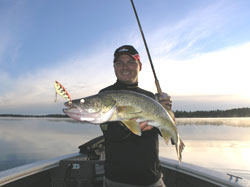
Go early. Stay late. Low light is better. Finesse is essential. These basic tenets of walleye fishing are fine and applicable during certain times of the year, but things change after Labor Day. Walleye become obstinate. Not in a way that makes them harder to catch, but instead they don’t follow the rules. Maybe they forget about the sure-fire way your grandfather caught walleye in June and the techniques that were a must for your fishing buddies in July. So what about the basic tenets? Throw ‘em out with the dead minnows.
Fall is a period of change, a shift from warm to cool and eventually to cold. Morning and evening windows of opportunity expand throughout the day and peak periods of activity occur when least expected. Morning emerges later and evening arrives earlier, creating a more concentrated period of ambient light. Walleye experience these transitions with periods of activity and lull, yet one mannerism remains true—the fish are hungry and their menu is fairly finite.
Leeches that scored big catches in spring and through the summer are now hard to come by, if not impossible. Average leech sizes decrease and jumbos resemble the medium stock from the past as trapping ponds shrivel into nothing.
Nightcrawlers will still produce, but as the late season progresses and water temperatures dive, fat minnows turn into the order of choice. Similar to other species, walleye become insatiable as winter’s winds loom beyond the horizon. Preparation for several months of meager meals and lowered metabolism prompts late fall activity and starting now, walleye action is gradually peaking.
Since minnows are preferred by even the most snobbish walleye, real and imitation varieties should be served ala carte. Shiners, cisco, and redtails are all great choices, but portion size is more relative. Carefully selecting a minnow in the 3 ½” to 6” range or crankbaits of similar proportion prove to be most effective.
If live bait is the daily special, then there are a couple of options for the perfect culinary presentation. A jig and minnow is a good beginning and pairing your feisty forage with a Lindy Maxx Gap Jig is just what you need to get the fish salivating. With its Techni-glo finish, the Maxx Gap emits a soft glow when charged, an often overlooked feature while the sun is at its peak. Dirty or stained water is the ideal situation for the Maxx Gap Jig. Cloud cover is also more common as Nor’easters blow in during fall and the Maxx Gap Jig is easily identified from a greater distance when light levels are diminished.
Another great option for a minnow is an age-old standard, the Lindy Rig. Because a Lindy Rig allows the minnow to freely room to a certain extent, the bait has a natural appearance that drives walleye wild. Not to mention the occasional northern pike or smallmouth bass. Longer leader lengths allow greater range of movement, while shorter snells confine the minnow’s movements.
The final presentation that receives raves is a crankbait. Trolling hard baits enables an angler to cover large expanses of water in smaller increments of time. But don’t overlook the productivity of casting a crankbait, especially along weed edges with fast tapering drops and sand or rock at the outer perimeter of the vegetation. Diving crankbaits are the standard for trolling, but many anglers surpass lipless crankbaits even though their effectiveness is premier in weedy situations. Tossing a bait like Salmo’s Zipper into medial depths of 8-15 feet will put big walleye in the boat if you rip the lure free from vegetation at the moment of contact. Bass anglers use this technique efficiently, but it’s also a great fall tactic for minnow hungry walleye.










